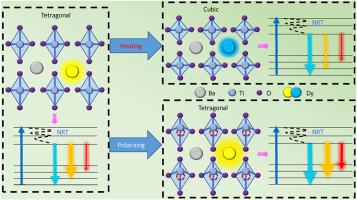Journal of Materiomics ( IF 9.4 ) Pub Date : 2023-12-22 , DOI: 10.1016/j.jmat.2023.11.016 Lei Xia , Xiao Liu , Zhan Mao , Yanbin Cai , Jing Zhu , Jiyang Xie , Wanbiao Hu

|
Lanthanide (Ln3+) based ferroelectric phosphors, with an integration of PL emission and ferroelectric effect, are unveiling an exciting realm of possibilities for multifunctional ferroelectric-optic materials. However, how the ferroelectric host enables the tuning on the PL emissions through modulating the local structure (e.g., lattice site, symmetry, strains etc.) of the Ln3+ activator is not established yet. In this work, a luminescent-ferroelectric material, i.e. Dy3+ doped BaTiO3 ceramic (Ba1–xDyxTiO3 (x = 0∼0.07), abbr: BTO:Dy3+), was explored to address the aforementioned issues. The BTO:Dy3+ ceramics were synthesized by a solid-state reaction method. The crystal structure, photoluminescence (PL) and electric properties (dielectric constant, ferroelectric hysteresis and piezoelectric hysteresis loop) were systematically investigated. The BTO:Dy3+ ceramics show two predominant emission peaks, corresponding to the blue magnetic dipole transition (477 nm, 4F7/2 → 6H15/2) and yellow electric dipole transition (573 nm, 4F7/2 → 6H13/2), the intensity ration of which can be modulated by the ferroelectric polarization that causes the slight lattice deformation. Such a polarization-emission modulation combining with the Dy3+ doping could accelerate the color change, from yellow to blue, which is characterized to detect the phase transition, with a method and mechanism were proposed, that is, the phase change is reflected by the PL characteristic peak intensity ratio. Therefore, the current results offer a convenient photoluminescence method for detecting the ferroelectric phase transition and a feasible approach to study the interaction between the photoluminescence and polarization in ferroelectric materials, for providing new insights for the development of multifunctional materials.
中文翻译:

镝掺杂钛酸钡铁电陶瓷的温度/电场诱导光致发光调制效应
镧系元素 (Ln 3+ ) 基铁电荧光体结合了 PL 发射和铁电效应,为多功能铁电光学材料开辟了令人兴奋的可能性领域。然而,铁电主体如何通过调节Ln 3+激活剂的局部结构(例如,晶格位点、对称性、应变等)来实现PL发射的调谐尚未确定。在这项工作中,我们探索了一种发光铁电材料,即Dy 3+掺杂 BaTiO 3陶瓷(Ba 1– x Dy x TiO 3 ( x = 0∼0.07),缩写:BTO:Dy 3+ )来解决上述问题。问题。采用固相反应法合成了BTO:Dy 3+陶瓷。系统地研究了晶体结构、光致发光(PL)和电性能(介电常数、铁电磁滞和压电磁滞回线)。BTO:Dy 3+陶瓷显示出两个主要发射峰,对应于蓝色磁偶极跃迁(477 nm,4 F 7/2 → 6 H 15/2)和黄色电偶极跃迁(573 nm,4 F 7/2 ) → 6 H 13/2 ),其强度比可以通过引起轻微晶格变形的铁电极化来调制。这种偏振发射调制结合Dy 3+掺杂可以加速颜色从黄色到蓝色的变化,其特点是检测相变,并提出了一种方法和机制,即将相变反映为PL特征峰强度比。因此,本研究结果为检测铁电相变提供了一种便捷的光致发光方法,为研究铁电材料光致发光与极化之间的相互作用提供了可行的途径,为多功能材料的开发提供了新的见解。



























 京公网安备 11010802027423号
京公网安备 11010802027423号